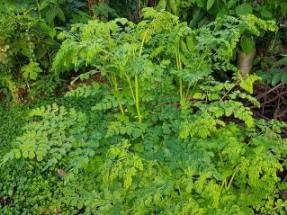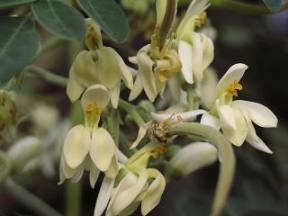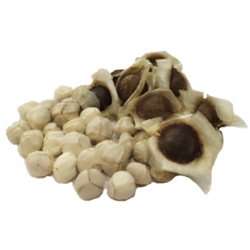Moringa
 Common Names: Moringa, drumstick tree, horseradish tree, ben oil tree, benzolive tree
Common Names: Moringa, drumstick tree, horseradish tree, ben oil tree, benzolive tree
Scientific Name: Moringa oleifera
Climate: Warm and temperate
Plant Description1: Moringa is an evergreen tree that loses its leaves easily. It reaches 10 to 12 m high. It has an open and scattered layer of inclined and fragile branches, the leaves are about 20 cm long, with thin, oblong or oval leaves of one to two cm long and light green color. The bark is whitish, the trunk is generally thick and irregular in size and shape, and the small and dense crown.
The flowers are numerous cream coloured, fragrant and bisexual. They measure from one to one and a half cm long, these are grouped together. The fruits are a brown capsule, three-sided with a papery sheath and sloping with longitudinal grooves that give the appearance of a pod. The fruit reaches maturity approximately 3 months after flowering.
 Cultivation: Moringa tolerates a wide range of environmental conditions, withstands high temperatures, and is very resistant to drought. The tree can resist a brief period of freezing temperatures, but benefits from being planted in a relatively warm and protected location. You can also be planted near the top of a sloping area, where cold winter air can drain to the bottom of the slope. It prefers sandy soils with good capacity to drain.
Cultivation: Moringa tolerates a wide range of environmental conditions, withstands high temperatures, and is very resistant to drought. The tree can resist a brief period of freezing temperatures, but benefits from being planted in a relatively warm and protected location. You can also be planted near the top of a sloping area, where cold winter air can drain to the bottom of the slope. It prefers sandy soils with good capacity to drain.
Moringa can be grown as an annual leaf crop anywhere with a long, warm summer. It should be planted in full sun, but tolerates half shade; watering should be kept to a minimum but on a regular basis. This tree is very resistant to drought and an excess of watering can rot its roots, for this reason it is advisable to plant it in well-drained soil. Fertilizer and good nitrogen are useful, especially for year-round production.
Moringa can be grown from seeds and cuttings. The seed can be sown directly in the soil or in the pots. The seed is sown in a tall seedbed and it is slightly watered. It is important to keep the soil slightly moist.
The seed takes up to 3 weeks to germinate. Then it can be sown directly into the ground. Make a square 30 cm wide with hole in the middle 25 cm deep. The seedling is placed in the hole with the twig towards the direction of the sun.
You can also sow seeds directly in the soil by making a 5 cm hole. Water lightly and cover with earth without pressure. Water with little water again. It is important to keep the soil slightly moist for about 7 to 10 days. The seed takes up to 2-3 weeks to germinate.
To reproduce by means of cuttings, the rods must be between 35 - 150 cm long and 5 to 12 cm thick. They have to dry a few days in the shade, then they are put on the ground with good drainage, and natural fertilizer, burying a third of it. The depth should be about 15 cm. In a few days the roots and new branches will begin to grow.
The recommended distance for planting trees or cuttings is 4 to 6 m away or at a distance of 2 meters in very cold places. Fertilizer and good nitrogen are useful, especially for year-round production. The way to harvest is to separate the leaves from the stems, although the branches can also be cut, but cuts in the rainy season can cause the tree to die. The harvested leaves should be dried in the shade and stored in a cool, dry place for future use.
 Uses: The leaves are the most nutritious part of the plant, being high in protein, calcium, iron, vitamin A and B-complex vitamins. They can be used raw or cooked, can be powdered and added to tea. This plant helps against inflammation, diabetes, respiratory problems, brain and liver function. If consumed in large quantities it can have laxative effects.
Uses: The leaves are the most nutritious part of the plant, being high in protein, calcium, iron, vitamin A and B-complex vitamins. They can be used raw or cooked, can be powdered and added to tea. This plant helps against inflammation, diabetes, respiratory problems, brain and liver function. If consumed in large quantities it can have laxative effects.
Pests and Diseases: Moringa is not affected by any serious diseases, but may be attacked by common garden pests like aphids, caterpillars in all areas, and fruit flies in warm climates. Use - Pyrethrum- based insecticides for these.
References:
En español: Moringa
